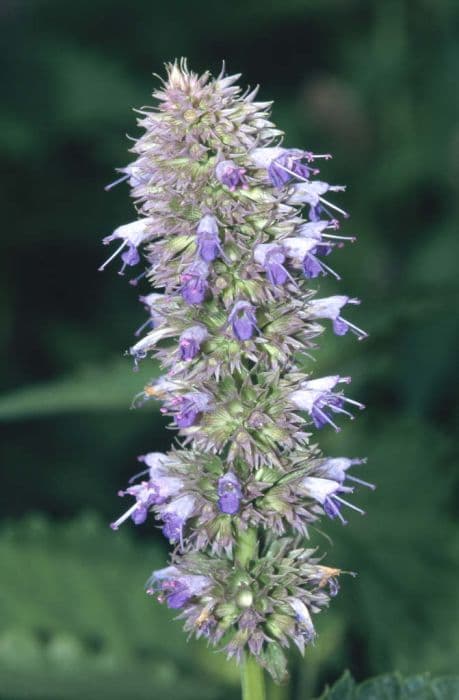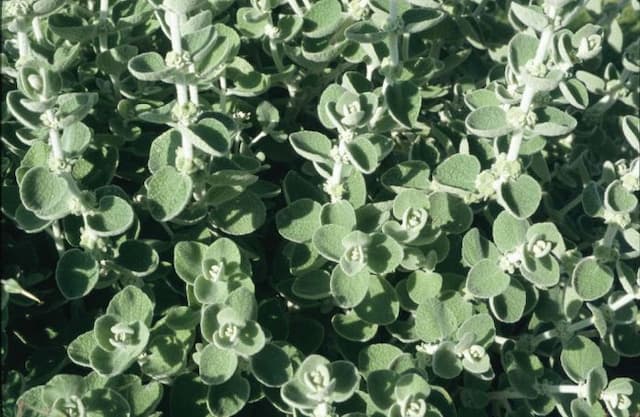Creeping Thyme Thymus serpyllum 'Snowdrift'

ABOUT
The plant you've asked about, commonly known as 'Snowdrift' creeping thyme, is a low-growing, spreading perennial cherished for its decorative and aromatic qualities. It boasts small, rounded leaves which are generally a grey-green hue and are densely packed along the slender, wiry stems. These leaves remain evergreen in milder climates, contributing to year-round interest. During flowering, the plant is adorned with a profusion of tiny, tubular flowers that can be best described as a blanket of pure white. These flowers often attract a variety of pollinators, including bees and butterflies. The appearance of 'Snowdrift' creeping thyme is enjoyed by gardeners seeking a ground cover with both visual appeal and fragrance, as the plant exudes a pleasant, minty aroma when its foliage is disturbed. Overall, it has a mat-forming habit that lends itself to being used in rock gardens, between paving stones, or as an ornamental feature in small-scale landscaping projects.
About this plant
 Names
NamesFamily
Lamiaceae
Synonyms
Snowdrift Thyme, Creeping Thyme, Wild Thyme, Mother-of-Thyme, Breckland Thyme
Common names
Thymus serpyllum.
 Toxicity
ToxicityTo humans
Creeping thyme 'Snowdrift' is not considered toxic to humans. It is actually commonly used as a culinary herb and has a history of use in traditional medicine. However, it's always advisable to consume plants in moderation and to consult with a healthcare provider before using any plant for medicinal purposes, especially if you have any pre-existing health conditions or are pregnant. There is typically no concern for toxicity or poisoning from ingesting creeping thyme in quantities normally found in food.
To pets
Creeping thyme 'Snowdrift' is not known to be toxic to pets. It is a plant that is often used in gardens and landscaping, and it's not generally associated with adverse reactions in animals. Pets may nibble on the leaves without expected symptoms of poisoning. However, as with any non-food plant, consumption in large quantities could potentially lead to gastrointestinal discomfort, so it is always best to monitor your pets and discourage them from eating plants not intended for their consumption.
 Characteristics
CharacteristicsLife cycle
Perennials
Foliage type
Evergreen
Color of leaves
Green
Flower color
White
Height
6 inches (15 cm)
Spread
18 inches (45 cm)
Plant type
Herb
Hardiness zones
4
Native area
Europe
Benefits
 General Benefits
General Benefits- Attracts Pollinators: Thymus serpyllum 'Snowdrift' produces flowers that attract bees, butterflies, and other beneficial insects.
- Drought Tolerant: Once established, it requires minimal watering, making it suitable for dry or xeriscape gardens.
- Ground Cover: Its low-growing habit helps to cover bare spots in the garden and suppress weeds.
- Aromatic Foliage: The leaves release a pleasant fragrance when crushed or brushed against.
- Culinary Use: The leaves can be used fresh or dried to flavor a variety of dishes.
- Ornamental: It produces attractive white flowers that can add beauty to a garden landscape.
- Easy to Grow: Generally hardy and easy to care for, making it suitable for beginner gardeners.
- Soil Erosion Control: Its mat-forming growth habit helps stabilize soil and prevent erosion.
- Wildlife Habitat: Offers shelter and nesting materials for a variety of small animals and insects.
- Tolerates Foot Traffic: Can withstand light foot traffic, making it a good choice for planting between pavers or in a lawn alternative.
 Medical Properties
Medical Properties- Antiseptic: Thymus serpyllum 'Snowdrift' contains thymol, which can act as an antiseptic.
- Antifungal: It has properties that can help combat certain fungal infections.
- Antispasmodic: May help relieve spasms in the muscles.
- Expectorant: Can assist in the clearance of mucus from the respiratory tract.
- Carminative: It can help reduce gas in the gastrointestinal tract.
 Air-purifying Qualities
Air-purifying QualitiesThis plant is not specifically known for air purifying qualities.
 Other Uses
Other Uses- Creeping Thyme 'Snowdrift' can be used as an aromatic stuffing for pillows and sachets, providing a gentle, calming fragrance to help with relaxation and sleep.
- The plant serves as a natural lawn alternative in landscaping, offering a low-maintenance, drought-resistant ground cover that tolerates foot traffic.
- It can be employed as a decorative plant in container gardens, hanging baskets, or window boxes for its lovely white flowers and lush green foliage.
- Creeping Thyme 'Snowdrift' is used in culinary applications, such as infusing oils and vinegars with its subtle flavor and pleasant aroma.
- The dried flowers and leaves can be incorporated into homemade potpourris, creating a natural and refreshing room scent.
- It acts as an excellent companion plant in gardens, helping to repel certain pests due to its aromatic properties.
- Creeping Thyme 'Snowdrift' can be used in crafting, such as making natural, decorative wreaths for doors and tables.
- The plant can be planted between pavers and stepping stones, providing a fragrant and aesthetic touch when stepped on, releasing its scent.
- Its dense growth habit makes it suitable for use in model railways or fairy gardens, creating a realistic miniature landscape.
- Creeping Thyme 'Snowdrift' can be used in dyeing fabrics, offering a natural source of color for textiles and wool.
Interesting Facts
 Feng Shui
Feng ShuiCreeping thyme is not used in Feng Shui practice.
 Zodiac Sign Compitability
Zodiac Sign CompitabilityCreeping thyme is not used in astrology practice.
 Plant Symbolism
Plant Symbolism- Courage: Wild thyme, a variety closely related to Thymus serpyllum 'Snowdrift', has historically been associated with bravery. During medieval times, it was a symbol for courage in battle.
- Healing: Thyme has a long-standing medicinal use, symbolizing health and healing. It was used by ancient civilizations as a remedy for various ailments.
- Purity: The 'Snowdrift' variety, with its white flowering nature, symbolizes purity and cleanliness. White blooms are often associated with innocence and unblemished beauty.
- Longevity: Thyme is an evergreen plant, which can symbolize longevity and eternal life.
- Affection: In the language of flowers, thyme can represent affection and fondness.
 Water
WaterCreeping thyme 'Snowdrift' should be watered regularly but with moderation to prevent waterlogging, as it’s susceptible to root rot. It prefers to dry out slightly between watering sessions. Ensure that the soil is moist to the touch, but not saturated. In general, provide about one inch of water per week, adjusting as necessary during hot, dry periods or rainy spells. Use the soak-and-dry method by applying water directly to the base until the first two inches of soil are moist. In terms of volume, this might translate to roughly 0.5 gallons per square foot every week, depending on the plant's environment and the local climate.
 Light
LightCreeping thyme 'Snowdrift' thrives best in full sun to partial shade conditions. It should be placed in a spot that receives at least six hours of direct sunlight daily. In very hot climates, it can benefit from light afternoon shade to protect it from intense heat.
 Temperature
TemperatureCreeping thyme 'Snowdrift' is hardy and can tolerate a wide range of temperatures but grows best in temperatures between 59°F and 86°F. It can withstand frost and survive in temperatures as low as -30°F and as high as 120°F. However, for optimal growth, ensure that the temperature remains within the ideal range.
 Pruning
PruningCreeping thyme 'Snowdrift' benefits from pruning to maintain its compact growth and to encourage new, lush foliage. It should be trimmed lightly after it has flowered, typically in late summer or early fall. Pruning just once a year is usually enough, and the best time is immediately after the blooming period.
 Cleaning
CleaningAs needed
 Soil
SoilCreeping Thyme 'Snowdrift' thrives in well-drained soil with a neutral to slightly alkaline pH, ideally between 6.5 and 7.5. A mixture of garden soil, coarse sand, and compost or peat moss is suitable, ensuring good drainage and aeration. It's crucial to avoid waterlogged conditions to prevent root rot.
 Repotting
RepottingCreeping Thyme 'Snowdrift' generally does not require frequent repotting and can thrive in the same container for several years. It should be repotted if it becomes root-bound or if the soil quality deteriorates, typically every 2-3 years.
 Humidity & Misting
Humidity & MistingCreeping Thyme 'Snowdrift' is well-suited to low to average humidity conditions and does not require high humidity. Natural ambient humidity is typically sufficient for this hardy herb.
 Suitable locations
Suitable locationsIndoor
Provide full sun and well-draining soil mix.
Outdoor
Plant in sunny spot with well-draining soil.
Hardiness zone
4-9 USDA
 Life cycle
Life cycleThymus serpyllum 'Snowdrift', commonly known as Wild Thyme or Creeping Thyme, begins its life cycle as a seed, which germinates in favorable conditions of warmth and moisture in late spring or early summer. Upon germination, the seedling emerges, establishing a small root system and a rosette of leaves close to the ground. As the plant matures, it develops a woody base and spreads outwards with its creeping stems, rooting at nodes to form a dense mat of foliage over time. Throughout late spring to summer, 'Snowdrift' produces clusters of white flowers that attract pollinators, which are essential for the cross-pollination and production of viable seeds. Once pollinated, the flowers develop into small seed capsules that release seeds, thus completing the reproductive cycle. In the fall and winter, the plant enters a period of dormancy, though the evergreen foliage remains, and it can survive through frost and snow, ready to grow again in the next spring.
 Propogation
PropogationPropogation time
Spring-Early Summer
Thymus serpyllum 'Snowdrift', commonly known as wild thyme or creeping thyme, is best propagated during the spring or early summer. The most popular method for new plants is through stem cuttings. To do this, you would take a 2 to 3-inch (5 to 7.5 centimeters) cutting from a healthy, non-flowering shoot. Remove the leaves from the lower half of the cutting and dip the cut end into a rooting hormone. Then, insert the stem into a pot of pre-moistened soil mix that drains well. Keep the pot in a warm place with indirect sunlight and maintain consistent moisture, being cautious not to overwater. Roots should begin to develop within a few weeks, after which you can gradually harden off the plant before transplanting outdoors.









